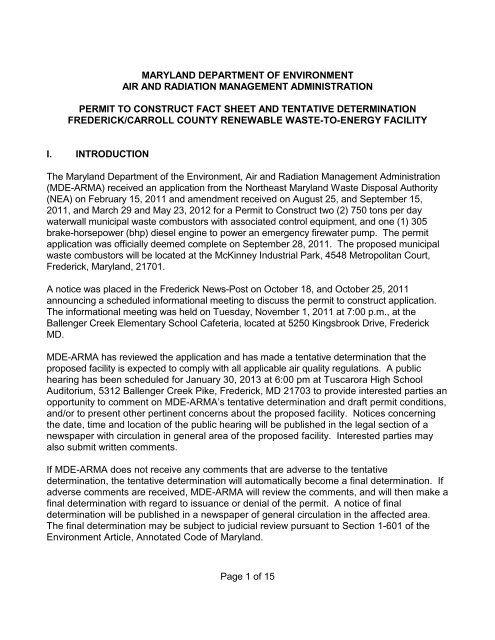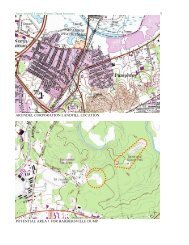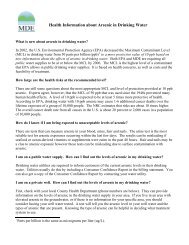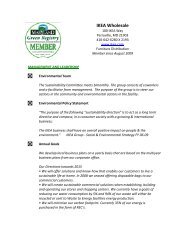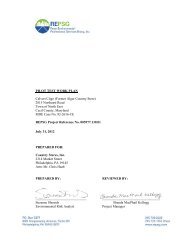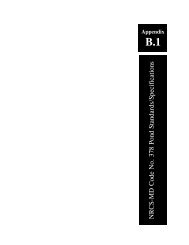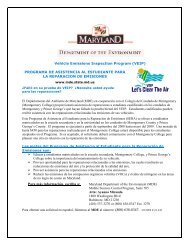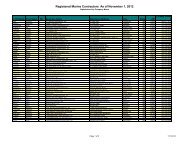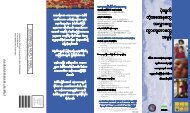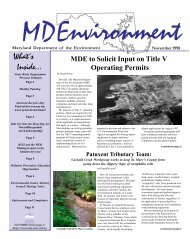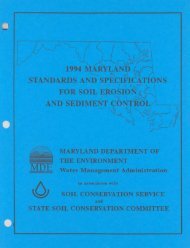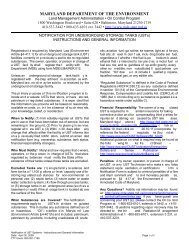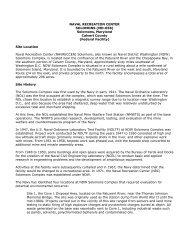fact sheet - Maryland Department of the Environment
fact sheet - Maryland Department of the Environment
fact sheet - Maryland Department of the Environment
Create successful ePaper yourself
Turn your PDF publications into a flip-book with our unique Google optimized e-Paper software.
MARYLAND DEPARTMENT OF ENVIRONMENT<br />
AIR AND RADIATION MANAGEMENT ADMINISTRATION<br />
PERMIT TO CONSTRUCT FACT SHEET AND TENTATIVE DETERMINATION<br />
FREDERICK/CARROLL COUNTY RENEWABLE WASTE-TO-ENERGY FACILITY<br />
I. INTRODUCTION<br />
The <strong>Maryland</strong> <strong>Department</strong> <strong>of</strong> <strong>the</strong> <strong>Environment</strong>, Air and Radiation Management Administration<br />
(MDE-ARMA) received an application from <strong>the</strong> Nor<strong>the</strong>ast <strong>Maryland</strong> Waste Disposal Authority<br />
(NEA) on February 15, 2011 and amendment received on August 25, and September 15,<br />
2011, and March 29 and May 23, 2012 for a Permit to Construct two (2) 750 tons per day<br />
waterwall municipal waste combustors with associated control equipment, and one (1) 305<br />
brake-horsepower (bhp) diesel engine to power an emergency firewater pump. The permit<br />
application was <strong>of</strong>ficially deemed complete on September 28, 2011. The proposed municipal<br />
waste combustors will be located at <strong>the</strong> McKinney Industrial Park, 4548 Metropolitan Court,<br />
Frederick, <strong>Maryland</strong>, 21701.<br />
A notice was placed in <strong>the</strong> Frederick News-Post on October 18, and October 25, 2011<br />
announcing a scheduled informational meeting to discuss <strong>the</strong> permit to construct application.<br />
The informational meeting was held on Tuesday, November 1, 2011 at 7:00 p.m., at <strong>the</strong><br />
Ballenger Creek Elementary School Cafeteria, located at 5250 Kingsbrook Drive, Frederick<br />
MD.<br />
MDE-ARMA has reviewed <strong>the</strong> application and has made a tentative determination that <strong>the</strong><br />
proposed facility is expected to comply with all applicable air quality regulations. A public<br />
hearing has been scheduled for January 30, 2013 at 6:00 pm at Tuscarora High School<br />
Auditorium, 5312 Ballenger Creek Pike, Frederick, MD 21703 to provide interested parties an<br />
opportunity to comment on MDE-ARMA’s tentative determination and draft permit conditions,<br />
and/or to present o<strong>the</strong>r pertinent concerns about <strong>the</strong> proposed facility. Notices concerning<br />
<strong>the</strong> date, time and location <strong>of</strong> <strong>the</strong> public hearing will be published in <strong>the</strong> legal section <strong>of</strong> a<br />
newspaper with circulation in general area <strong>of</strong> <strong>the</strong> proposed facility. Interested parties may<br />
also submit written comments.<br />
If MDE-ARMA does not receive any comments that are adverse to <strong>the</strong> tentative<br />
determination, <strong>the</strong> tentative determination will automatically become a final determination. If<br />
adverse comments are received, MDE-ARMA will review <strong>the</strong> comments, and will <strong>the</strong>n make a<br />
final determination with regard to issuance or denial <strong>of</strong> <strong>the</strong> permit. A notice <strong>of</strong> final<br />
determination will be published in a newspaper <strong>of</strong> general circulation in <strong>the</strong> affected area.<br />
The final determination may be subject to judicial review pursuant to Section 1-601 <strong>of</strong> <strong>the</strong><br />
<strong>Environment</strong> Article, Annotated Code <strong>of</strong> <strong>Maryland</strong>.<br />
Page 1 <strong>of</strong> 15
II.<br />
PROPOSED INSTALLATION<br />
Wheelabrator Technologies, Inc. (WTI) has entered into a contract with <strong>the</strong> Nor<strong>the</strong>ast<br />
<strong>Maryland</strong> Waste Disposal Authority (NEA) to develop, construct and operate a nominal<br />
1,500 ton per day Frederick/Carroll County Renewable Waste-to-Energy Facility<br />
(FCCRWTE) in Frederick County. The project will be located on an 11-acre site in <strong>the</strong><br />
McKinney Industrial Park (near <strong>the</strong> intersection <strong>of</strong> English Muffin Way and Buckeystown<br />
Pike) in Frederick County, <strong>Maryland</strong> and will serve <strong>the</strong> long term solid waste disposal<br />
needs <strong>of</strong> both Frederick and Carroll Counties (<strong>the</strong> Counties). The FCCRWTE project<br />
will consist <strong>of</strong> two (2) nominal 750 ton per day (tpd) municipal solid waste combustors.<br />
The combustion gases will be sent to <strong>the</strong> vertical convection pass boilers, which<br />
produce steam for <strong>the</strong> steam turbine generator which is capable <strong>of</strong> producing<br />
approximately 51 megawatts (MW) gross (45 MW net) <strong>of</strong> electricity. FCCRWTE will<br />
also combust a small amount <strong>of</strong> wastewater treatment sludge (i.e., sewage sludge) and<br />
tires. Combustor burners will fire pipeline quality natural gas during startup, shutdown,<br />
and to maintain minimum temperatures in <strong>the</strong> combustors.<br />
The major air pollutant-emitting equipment and operations <strong>of</strong> <strong>the</strong> FCCRWTE consist <strong>of</strong><br />
<strong>the</strong> following: two (2) water-walled combustors feeding two vertical convection four-pass<br />
boilers; gas-fired startup/auxiliary burners integral to <strong>the</strong> combustors; reagent materialhandling<br />
systems; fly and bottom ash-handling and metals recovery systems; one (1)<br />
wet mechanical draft cooling tower; and one (1) emergency firewater pump diesel<br />
engine.<br />
III.<br />
APPLICABLE REGULATIONS<br />
The proposed installation is subject to all applicable Federal and State air quality control<br />
regulations, including, but not limited to <strong>the</strong> following:<br />
(a)<br />
This source is subject to all applicable federal air pollution control requirements<br />
including, but not limited to, <strong>the</strong> following:<br />
For Municipal Waste Combustors Only<br />
(1) 40 CFR 60, Subparts A and Eb – Standards <strong>of</strong> Performance for Large<br />
Municipal Waste Combustors. – which states standards <strong>of</strong> performance,<br />
applicable terms, provisions, emissions standards, testing, monitoring,<br />
record keeping, and reporting requirements for large municipal waste<br />
combustors that commenced construction after September 20, 1994 or<br />
for which modification or reconstruction is commenced After June 19,<br />
1996, including <strong>the</strong> following:<br />
§60.52b – Standards for Municipal Waste Combustor Metals, Acid<br />
Gases, Organics, and Nitrogen Oxides. – which states emission limits<br />
from municipal waste combustors for particulate matter, cadmium, lead,<br />
mercury, acid gases, sulfur dioxide, hydrogen chloride, organics,<br />
2
dioxin/furan, and nitrogen oxides.<br />
§60.53b – Standards for Municipal Waste Combustor Operating<br />
Practices. – which states operating practices for municipal waste<br />
combustors for emissions <strong>of</strong> carbon monoxide, particulate matter,<br />
dioxin/furan, and mercury.<br />
§60.54b – Standards for Municipal Waste Combustor Operator Training<br />
and Certification. – which requires training practices, and certification<br />
requirements for municipal waste combustor operators, <strong>the</strong> development<br />
and update on a yearly basis a site-specific operating manual that shall,<br />
at a minimum, address <strong>the</strong> elements <strong>of</strong> municipal waste combustor unit<br />
operation.<br />
§60.55b – Standards for municipal waste combustor fugitive ash<br />
emissions. – which requires that no owner or operator <strong>of</strong> an affected<br />
facility shall cause to be discharged to <strong>the</strong> atmosphere visible emissions<br />
<strong>of</strong> combustion ash from an ash conveying system (including conveyor<br />
transfer points) in excess <strong>of</strong> 5 percent <strong>of</strong> <strong>the</strong> observation period (i.e., 9<br />
minutes per 3-hour period), as determined by EPA Reference Method 22<br />
observations.<br />
A summary <strong>of</strong> <strong>the</strong> NSPS Subpart Eb emissions standards applicable to<br />
<strong>the</strong> Frederick/Carroll County Renewable Waste to Energy Facility is in<br />
<strong>the</strong> Table shown below:<br />
Pollutant<br />
PM<br />
Opacity<br />
NO x<br />
SO 2<br />
CO<br />
HCl<br />
Limit<br />
20 mg/dscm @7% O 2 [average <strong>of</strong> 3 test runs]<br />
10% [6-minute average]<br />
During 1-yr: 180 ppmvd @7% O 2 (dry basis);<br />
After 1-yr:150 ppmvd @ 7% O 2 (dry basis)<br />
30 ppmvd or 20% potential SO 2 emission<br />
conc. (80% reduction by wt or vol) @ 7%<br />
O 2 (dry basis), whichever is less stringent<br />
100 ppmvd @7% O 2 (dry basis) [4-hr<br />
average]<br />
25 ppmvd or 5% potential HCl emission<br />
conc. (95% reduction by wt or vol) @7%<br />
O 2 (dry basis), whichever is less stringent<br />
Page 3 <strong>of</strong> 15
Pollutant<br />
Hg<br />
MWC Organics<br />
(Dioxin/Furans)<br />
Cd<br />
Pb<br />
Limit<br />
50 µg/dscm or 15% potential Hg emission<br />
conc. (85% reduction by wt) @7% O 2,<br />
whichever is less stringent<br />
13 ng/dscm (total mass) @7% O 2<br />
10 µg/dscm @7% O 2 [average <strong>of</strong> 3 test runs<br />
or more]<br />
140 µg/dscm @7% O 2 [average <strong>of</strong> 3 test<br />
runs or more]<br />
Fugitive Ash<br />
Emissions to<br />
Atmosphere<br />
No visible emission to <strong>the</strong> atmosphere in<br />
excess <strong>of</strong> 5% <strong>of</strong> <strong>the</strong> observation period<br />
(i.e., ≤ 9 minutes per 3-hour period),<br />
except as provided under 40 CFR 60.55b<br />
(b) and (c).<br />
Notes: mg/m 3 = milligrams per cubic meter; ppmvd = parts per million by volume on a dry basis; ug/m 3 =<br />
micrograms per dry standard cubic meters.<br />
For Internal Combustion Engine Only<br />
(2) 40 CFR Part 60, Subparts A (General Provisions) and Subpart IIII –<br />
Standards <strong>of</strong> Performance for Stationary Compression Ignition Internal<br />
Combustion Engines (CI ICE). – which states all applicable terms,<br />
provisions, emissions standards, testing, monitoring, record keeping, and<br />
reporting requirements included in federal New Source Performance<br />
Standards (NSPS) for <strong>the</strong> performance for Stationary Compression<br />
Ignition Internal Combustion Engines (CI ICE), including <strong>the</strong> following:<br />
§60.4202 – What emission standards must I meet for emergency<br />
engines if I am a stationary CI internal combustion engine manu<strong>fact</strong>urer?<br />
– which requires that stationary CI internal combustion engine<br />
manu<strong>fact</strong>urers to certify <strong>the</strong>ir fire pump stationary CI ICE to <strong>the</strong> emission<br />
standards in table 4 to this subpart, for all pollutants, for <strong>the</strong> same model<br />
year and NFPA nameplate power.<br />
A summary <strong>of</strong> <strong>the</strong> NSPS Subpart IIII, emissions standards applicable to<br />
<strong>the</strong> emergency firewater pump diesel engine at Frederick/Carroll County<br />
Renewable Waste to Energy Facility is shown in Table below.<br />
4
__________________________________________________________<br />
Excerpt from Table 4 to Subpart IIII <strong>of</strong> Part 60 “NO x , NMHC, CO and PM Emission<br />
Standards in g/kW-hr (g/Hp-hr) for Emergency Fire Pump Engines<br />
Maximum<br />
Engine<br />
Power Model Year NMHC+NO x CO PM<br />
300≤HP
– which states <strong>the</strong> requirements and procedures regarding continuous<br />
emission monitors for municipal waste combustors with a burning<br />
capacity <strong>of</strong> 35 tons or greater per day.<br />
(6) COMAR 26.11.02.04 – Duration <strong>of</strong> Permits. – which specifies <strong>the</strong><br />
duration, and expiration <strong>of</strong> permits to construct, permits to operate,<br />
temporary permits, portable emission units, and Part 70 permits.<br />
(7) COMAR 26.11.02.09A – Sources Subject to Permit to Construct and<br />
Approvals. – which list source categories subject to permit to construct<br />
approvals.<br />
(8) COMAR 26.11.02.13A – Sources Subject to State Permits to Operate.<br />
– which states that a person may not operate or cause to be operated<br />
any <strong>of</strong> <strong>the</strong> following source without first obtaining, and having in current<br />
effect, a State permit to operate as required by this regulation: (61) Any<br />
o<strong>the</strong>r source that <strong>the</strong> <strong>Department</strong> determines has <strong>the</strong> potential to have a<br />
significant impact on air quality.”<br />
(9) COMAR 26.11.03.02 – Applications for Part 70 Permits. General<br />
Requirement. – which states <strong>the</strong> requirements and procedures for<br />
sources subjected to Part 70 permits.<br />
(10) COMAR 26.11.06.03D – Fugitive Particulate Matter from Materials<br />
Handling and Construction. – which states that “a person may not cause<br />
or permit any material to be handled, transported, or stored, or a<br />
building, its appurtenances, or a road to be used, constructed, altered,<br />
repaired, or demolished without taking reasonable precautions to<br />
prevent particulate matter from becoming airborne.”<br />
(11) COMAR 26.11.06.12 – Control <strong>of</strong> NSPS Source. – which states that “a<br />
person may not construct, modify, or operate, or cause to be<br />
constructed, modified, or operated, a New Source Performance<br />
Standard (NSPS) source as defined in COMAR 26.11.01.01C, which<br />
results or will result in violation <strong>of</strong> <strong>the</strong> provisions <strong>of</strong> 40 CFR 60, as<br />
amended.”<br />
(12) COMAR 26.11.06.14 – Control <strong>of</strong> PSD Source. – which states that “a<br />
person may not construct, modify, or operate, or cause to be<br />
constructed, modified, or operated, a Prevention <strong>of</strong> Significant<br />
Deterioration (PSD) source, as defined in COMAR 26.11.01.01B(37),<br />
which will result in violation <strong>of</strong> any provision <strong>of</strong> 40 CFR §52.21, as<br />
published in <strong>the</strong> 2009 edition, as amended by <strong>the</strong> “Prevention <strong>of</strong><br />
Significant Deterioration and Title V Greenhouse Gas Tailoring Rule” (75<br />
FR 31514).<br />
6
For Municipal Waste Combustors Only<br />
(13) COMAR 26.11.08.02E – Control <strong>of</strong> Incinerators. Applicability.<br />
– which states that a “MWC with a capacity greater than 250 tons per<br />
day for which construction began after September 20, 1994, or<br />
modification or reconstruction began after June 19, 1996, is also subject<br />
to <strong>the</strong> requirements <strong>of</strong> 40 CFR Part 60 Subpart Eb, Standards <strong>of</strong><br />
Performance for Municipal Waste Combustors, as amended,<br />
incorporated by reference at COMAR 26.11.06.12.”<br />
(14) COMAR 26.11.08.04 – Visible Emissions Standards. – which states<br />
visible emission standard for <strong>the</strong> discharge <strong>of</strong> emission from any<br />
incinerator, and provides exceptions during start-up, or adjustments or<br />
occasional cleaning <strong>of</strong> control equipment.<br />
(15) COMAR 26.11.08.09 – Incinerator Operator Training. – which requires<br />
incinerator operator training and certification approved by MDE-ARMA.<br />
For Internal Combustion Engine Only<br />
(16) COMAR 26.11.09.05E(2) – Visible Emissions. – which states visible<br />
emission requirements during idle mode, and operating mode for <strong>the</strong><br />
engine, as well as exceptions from <strong>the</strong> regulation.<br />
(17) COMAR 26.11.09.07A(1)(c) – Sulfur Content Limitations for Fuel. – In<br />
Areas I, II, V, and VI. – which states sulfur content limitations for <strong>the</strong><br />
distillate fuel oils to less than 0.3 percent by weight.” Note: Installations<br />
subject to 40 CFR Part 60, Subpart IIII must comply with <strong>the</strong> fuel<br />
standards <strong>of</strong> §60.4207 which limit <strong>the</strong> maximum sulfur content <strong>of</strong> <strong>the</strong> fuel<br />
to 15 ppm.<br />
For <strong>the</strong> Cooling Tower only<br />
(18) COMAR 26.11.06.02C(2) – Visible Emission Standards.<br />
“(1) In Areas I, II, V, and VI a person may not cause or permit <strong>the</strong><br />
discharge <strong>of</strong> emissions from any installation or building, o<strong>the</strong>r than water<br />
in an uncombined form, which is greater than 20 percent opacity.”<br />
COMAR 26.11.06.02A(2) – Exceptions:<br />
“The visible emissions standards in §C <strong>of</strong> this regulation do not apply to<br />
emissions during start-up and process modifications or adjustments, or<br />
occasional cleaning <strong>of</strong> control equipment, if:<br />
(a) The visible emissions are not greater than 40 percent opacity; and<br />
(b) The visible emissions do not occur for more than 6 consecutive<br />
minutes in any 60 minute period.”<br />
Page 7 <strong>of</strong> 15
(19) COMAR 26.11.17.03 – Nonattainment Provisions for Major New<br />
Sources. – General Conditions.<br />
– which states that “a person who proposes to construct or modify and<br />
emissions unit subject to this chapter may not commence construction <strong>of</strong><br />
<strong>the</strong> emissions unit without first obtaining all permits and approvals<br />
required under this subtitle.”<br />
(c)<br />
This source is subject to all applicable State-only enforceable air pollution control<br />
requirements including, but not limited to, <strong>the</strong> following regulations:<br />
(1) COMAR 26.11.02.19C & D – Information Required to be Maintained by<br />
a Source and Emission Certifications. – which require that <strong>the</strong> Permittee<br />
submit to MDE-ARMA annual certifications <strong>of</strong> emissions, and that <strong>the</strong><br />
Permittee maintain sufficient records to support <strong>the</strong> emissions<br />
information presented in such submittals.<br />
(2) COMAR 26.11.06.08 and 26.11.06.09 – Nuisance and Odors. – which<br />
generally prohibit <strong>the</strong> discharge <strong>of</strong> emissions beyond <strong>the</strong> property line in<br />
such a manner that a nuisance or air pollution is created.<br />
(3) COMAR 26.11.15.05A – Control Technology Requirements (T-BACT)<br />
New or Reconstructed Installations. – which requires that <strong>the</strong> Permittee<br />
implement “Best Available Control Technology for Toxics” (T – BACT) to<br />
control emissions <strong>of</strong> toxic air pollutants.<br />
(4) COMAR 26.11.15.06A – Ambient Impact Requirements. Requirements<br />
for New Installations, Sources, or Premises.<br />
– which prohibits <strong>the</strong> discharge <strong>of</strong> toxic air pollutants to <strong>the</strong> extent that<br />
such emissions would unreasonably endanger human health.<br />
(d)<br />
(e)<br />
IV.<br />
The Permittee is subject to <strong>the</strong> emission limits and standards specified in <strong>the</strong><br />
PSD Approval No. PSD-2012-001.<br />
The Permittee is subject to <strong>the</strong> emission limits and standards specified in <strong>the</strong><br />
NSR Approval No. NSR-2012-001<br />
GENERAL AIR QUALITY<br />
The U.S. <strong>Environment</strong>al Protection Agency (EPA) has established primary and<br />
secondary National Ambient Air Quality Standards (NAAQS) for six (6) criteria<br />
pollutants, i.e., sulfur dioxide, particulate matter, carbon monoxide, nitrogen dioxide,<br />
ozone, and lead. The primary standards were established to protect public health,<br />
and <strong>the</strong> secondary standards were developed to protect against non-health effects<br />
such as damage to property and vegetation.<br />
8
MDE-ARMA utilizes a statewide air monitoring network, operated in accordance with<br />
EPA guidelines, to measure <strong>the</strong> concentrations <strong>of</strong> criteria pollutants in <strong>Maryland</strong>’s<br />
ambient air. The measurements are used to project statewide ambient air quality, and<br />
currently indicate that with <strong>the</strong> exception <strong>of</strong> ozone and fine particulate matter equal to<br />
or less than 2.5 microns in size (PM2.5), Frederick County is in attainment for all o<strong>the</strong>r<br />
National Ambient Air Quality Standards (NAAQS) criteria pollutants. Therefore,<br />
emissions <strong>of</strong> nitrogen oxides (NO x ), carbon monoxide (CO), sulfur dioxide (SO 2 ),<br />
particulate matter with particle size equal to or less than 10 microns in size (PM10),<br />
and lead (Pb) must be evaluated subject to Prevention <strong>of</strong> Significant (PSD) regulations<br />
promulgated in 40 CFR 52.21.<br />
Effective April 12, 2010, EPA established a new 1-hour primary and secondary NO 2<br />
NAAQS. EPA set <strong>the</strong> level <strong>of</strong> this new 1-hour NO 2 standard at 100 parts per billion<br />
(ppb). Final area designations with respect to this new 1-hour NO 2 standard have not<br />
been finalized; however, facilities subject to PSD applicability for NO 2 must<br />
demonstrate compliance with <strong>the</strong> 1-hour NO 2 NAAQS.<br />
Effective August 23, 2010, EPA established a new 1-hour primary SO 2 NAAQS that<br />
will eventually replace <strong>the</strong> current 24-hour and annual NAAQS. EPA set <strong>the</strong> level <strong>of</strong><br />
this new 1-hour SO 2 standard at 75 ppb. Final area designations with respect to <strong>the</strong><br />
new 1-hour SO 2 standard have not been finalized; however, facilities subject to PSD<br />
applicability for SO 2 must demonstrate compliance with this 1-hour SO 2 NAAQS.<br />
Ground level ozone continues to present a problem for <strong>the</strong> entire Baltimore-<br />
Washington metropolitan area, which is classified as a non-attainment area for ozone.<br />
The primary contributors to <strong>the</strong> formation <strong>of</strong> ozone are emissions <strong>of</strong> oxides <strong>of</strong> nitrogen,<br />
primarily from combustion equipment, and emissions <strong>of</strong> Volatile Organic Compounds<br />
(VOC) such as paint solvents and gasoline vapors. Frederick County is included in<br />
<strong>the</strong> non-attainment area for ozone.<br />
Air emission limitations and pollution control requirements are generally more stringent<br />
for sources located in areas that do not currently attain a NAAQS for a particular<br />
pollutant (known as “non-attainment” areas). The FCCRWTE project is located in<br />
Frederick County, which is designated as a moderate non-attainment area for ozone<br />
and non-attainment for PM2.5. If emissions <strong>of</strong> NO x or VOCs (as ozone precursors)<br />
from <strong>the</strong> project are greater than 25 tons per year (tpy), <strong>the</strong>n NA-NSR is triggered for<br />
ozone. Similarly, if direct emissions <strong>of</strong> PM2.5 or its precursors (SO 2 ) are greater than<br />
100 tpy, <strong>the</strong> project will trigger non-attainment new source review (NA-NSR) for<br />
PM2.5.<br />
With regard to toxic air pollutants (TAPs), screening levels (i.e., acceptable ambient<br />
concentrations for toxic air pollutants) are generally established at 1/100 <strong>of</strong> allowed<br />
Page 9 <strong>of</strong> 15
worker exposure levels (TLVs) 1 . MDE-ARMA has also developed additional screening<br />
levels for carcinogenic compounds. The additional screening levels are established<br />
such that continuous exposure to <strong>the</strong> subject TAP at <strong>the</strong> screening level for a period <strong>of</strong><br />
70 years is expected to cause an increase in lifetime cancer risk <strong>of</strong> no more than 1 in<br />
100,000.<br />
V. MERCURY TESTING, MONITORING, AND MITIGATION<br />
Emissions <strong>of</strong> mercury were analyzed as part <strong>of</strong> <strong>the</strong> PSD pollutant review <strong>of</strong> MWC<br />
Metals which include cadmium (Cd), lead (Pb), and mercury (Hg). (See “Review <strong>of</strong><br />
Prevention <strong>of</strong> Significant Deterioration Approval Application”). With respect to Hg,<br />
NSPS Subpart Eb sets a numeric emission standard for Hg at 50 ug/dscm corrected<br />
to 7% O 2 or 85% removal efficiency, whichever is less stringent. However, this limit is<br />
superseded by a PSD BACT limit established at 17 ug/dscm, corrected to 7% O 2 .<br />
Compliance with <strong>the</strong> short term Hg standard shall be demonstrated by using EPA<br />
Reference Method 29, except as prescribed in 40 CFR 60.58b(d)(4) and n.<br />
Based on <strong>the</strong> short term emission rate <strong>of</strong> 17 ug/dscm, <strong>the</strong> annual Hg emissions<br />
from <strong>the</strong> facility cannot exceed 92 pounds in any consecutive 12 month rolling<br />
period. In <strong>the</strong> event <strong>the</strong> Hg mass emissions exceed 92 pounds during any<br />
consecutive 12 month period, <strong>the</strong> Permittee must secure <strong>the</strong> services <strong>of</strong> an<br />
independent environmental consultant to perform an optimization study <strong>of</strong> <strong>the</strong><br />
Hg control technology and prepare a report that includes recommendations for<br />
improving <strong>the</strong> efficiency <strong>of</strong> <strong>the</strong> control technology. Upon MDE review and<br />
approval <strong>of</strong> <strong>the</strong> report, <strong>the</strong> Permittee is obligated to implement <strong>the</strong> report<br />
recommendations within 60 days unless MDE agrees to an extended<br />
implementation schedule.<br />
To demonstrate compliance with <strong>the</strong> annual mass limit for Hg, <strong>the</strong> Permittee<br />
must install one <strong>of</strong> <strong>the</strong> two Hg monitoring options described below:<br />
a. A continuous emissions monitoring system for Hg on each combustor in<br />
accordance with 40 CFR 60.58b(d)(4); or<br />
b. A sorbent trap Hg CEM installed and operated in accordance with<br />
Performance Specification 12B.<br />
Finally, as part <strong>of</strong> a mercury mitigation project involving public outreach, <strong>the</strong><br />
Permittee is required to establish a memorandum <strong>of</strong> understanding (MOU)<br />
between MDE-ARMA and <strong>the</strong> Permittee prior to <strong>the</strong> commencement <strong>of</strong><br />
construction. The MOU will include a provision requiring <strong>the</strong> Permittee to<br />
1 TLVs are threshold limit values (exposure limits) established for toxic materials by <strong>the</strong><br />
American Conference <strong>of</strong> Governmental Industrial Hygienists (ACGIH). Some TLVs are<br />
established for short-term exposure (TLV – STEL), and some are established for longer-term<br />
exposure (TLV – TWA), where TWA is an acronym for time-weight average.<br />
10
contribute $30,000 annually for a period <strong>of</strong> ten years for <strong>the</strong> purpose <strong>of</strong><br />
achieving <strong>the</strong> specific goals established in <strong>the</strong> MOU.<br />
VI.<br />
COMPLIANCE DEMONSTRATION AND ANALYSIS<br />
The proposed installation must comply with all State imposed emissions limitations and<br />
screening levels, as well as <strong>the</strong> NAAQS. MDE-ARMA has conducted an engineering<br />
and air quality review <strong>of</strong> <strong>the</strong> application. The emissions were projected based on vendor<br />
data, manu<strong>fact</strong>urer’s emission guarantees, and published emission <strong>fact</strong>ors for similar<br />
sources. A comprehensive dispersion modeling protocol was conducted to assess <strong>the</strong><br />
FCCRWTE air quality impacts in accordance with <strong>the</strong> methodology described in<br />
Section 6.0 <strong>of</strong> <strong>the</strong> air quality construction application. The applicant assessed and<br />
provided results <strong>of</strong> <strong>the</strong> air quality assessment with respect to PSD Class II area<br />
impacts. The applicant also assessed and presented results <strong>of</strong> air quality impacts at<br />
<strong>the</strong> distant PSD Class I areas resulting from long-range transport.<br />
The proposed project was evaluated to determine whe<strong>the</strong>r potential emissions <strong>of</strong><br />
regulated pollutants will be above <strong>the</strong> PSD major source thresholds for this type <strong>of</strong><br />
source. Results are presented in Table 1-A <strong>of</strong> MDE-ARMA’s review and tentative<br />
determination <strong>of</strong> <strong>the</strong> FCCRWTE PSD application.<br />
Municipal incinerators capable <strong>of</strong> charging more than 250 tons per day <strong>of</strong> refuse are<br />
one <strong>of</strong> <strong>the</strong> listed 28 source categories that trigger PSD at <strong>the</strong> 100 ton per year (tpy)<br />
threshold. If <strong>the</strong> potential annual emission <strong>of</strong> any criteria pollutant exceeds 100 tpy,<br />
<strong>the</strong>n <strong>the</strong> project is deemed to be a major stationary source subject to PSD. In <strong>the</strong><br />
case <strong>of</strong> <strong>the</strong> FCCRWTE project, both NO x and CO exceeded <strong>the</strong> emission threshold.<br />
Additionally, any o<strong>the</strong>r regulated pollutant with a potential to emit that exceeds<br />
applicable PSD Significant Emission Rates (SERs) are also subject to PSD review. A<br />
summary <strong>of</strong> PSD Applicability Analysis for Proposed Project, including <strong>the</strong> PSD SERs,<br />
can be found in Table 2 <strong>of</strong> MDE-ARMA’s PSD review. As indicated in Table 2,<br />
potential emissions <strong>of</strong> NO x , CO, SO 2 , PM 10 , total fluorides, sulfuric acid mist (SAM),<br />
MWC acid gases, MWC metals, MWC organics, and GHGs exceed <strong>the</strong> significance<br />
thresholds, and are <strong>the</strong>refore subject to PSD review.<br />
Potential emissions from new sources in non-attainment areas are also evaluated<br />
through <strong>the</strong> Non-Attainment New Source Review (NA-NSR) permitting program under<br />
Code <strong>of</strong> <strong>Maryland</strong> Regulations (COMAR) 26.11.17. The proposed project at<br />
FCCRWTE is subject to NA-NSR review for NO x emissions. A technical review <strong>of</strong> <strong>the</strong><br />
proposed project was conducted and results were summarized in MDE-ARMA’s<br />
“Review <strong>of</strong> Non-Attainment New Source Review Approval Application (NSR Approval<br />
NSR-2012-001). Table 2 <strong>of</strong> <strong>the</strong> NA-NSR review document lists <strong>the</strong> potential annual<br />
emissions <strong>of</strong> VOCs, NO x , PM2.5, and SO 2 , and <strong>the</strong>ir respective NA-NSR applicability<br />
thresholds. It was determined that only NO x emissions would exceed <strong>the</strong> applicable<br />
NA-NSR threshold and <strong>the</strong>refore be subject to NA-NSR review.<br />
Page 11 <strong>of</strong> 15
The FCCRWTE will be located in Frederick County, which is designated as a<br />
moderate non-attainment area for ozone and non-attainment for PM 2.5 . If emissions <strong>of</strong><br />
NO x or VOCs (as ozone precursors) from <strong>the</strong> project are greater than 25 tons per year<br />
(tpy), <strong>the</strong>n NA-NSR is triggered for ozone. Similarly, if direct emissions <strong>of</strong> PM 2.5 or its<br />
precursors (SO 2 ) are greater than 100 tpy, <strong>the</strong> project will trigger NA-NSR for PM 2.5<br />
and/or SO 2 . NO x emissions from <strong>the</strong> FCCRWTE will exceed 25 tons per year and<br />
trigger NA-NSR review. Because <strong>the</strong> permit to construct <strong>the</strong> FCCRWTE imposes<br />
enforceable limits on <strong>the</strong> annual SO 2 emissions from <strong>the</strong> FCCRWTE below <strong>the</strong> NA-<br />
NSR threshold <strong>of</strong> 100 tpy, no NA-NSR review <strong>of</strong> PM2.5 or its precursors (SO 2 ) is<br />
required.<br />
The NSR Approval NSR-2012-001, also details information regarding major NA-NSR<br />
requirements to control NO x emissions from <strong>the</strong> proposed project which include <strong>the</strong><br />
implementation <strong>of</strong> lowest achievable emission rate (LAER) for pollution control<br />
(summarized in Table 3); obtaining emissions reductions (<strong>of</strong>fsets) for significant<br />
pollutants; certifying that all o<strong>the</strong>r sources in <strong>Maryland</strong> owned by NEA are in<br />
compliance with all applicable requirements <strong>of</strong> <strong>the</strong> Clean Air Act; and in accordance<br />
with COMAR 26.11.17.03B(6), conduct “an analysis <strong>of</strong> alternative sites, sizes,<br />
production processes, and environmental control techniques that demonstrates that<br />
benefits <strong>of</strong> <strong>the</strong> proposed source significantly outweigh <strong>the</strong> environmental and social<br />
costs imposed as a result <strong>of</strong> its location, construction or modification.”<br />
Assessments <strong>of</strong> TAPs air quality impacts from <strong>the</strong> facility were conducted using <strong>the</strong><br />
AERMOD dispersion model and following proper modeling procedures, meteorology,<br />
and receptor grids, as described in Section 6.0 <strong>of</strong> <strong>the</strong> permit application submitted by<br />
NEA. Table II summarizes <strong>the</strong> refined AERMOD TAP results for <strong>the</strong> FCCRWTE<br />
combustors. This table shows <strong>the</strong> combustor TAP emission rates for <strong>the</strong> 110 and 60<br />
percent maximum continuous rating (MCR) operating cases, merged flue stack<br />
parameters for each MCR operating case, and nominal 1.0 g/s and individual TAP<br />
maximum air quality impacts for each averaging period. Table II shows that maximum<br />
TAP air quality impacts were found to be below <strong>the</strong> MDE screening levels.<br />
VII.<br />
TENTATIVE DETERMINATION<br />
Based on <strong>the</strong> above information, MDE-ARMA has concluded that <strong>the</strong> proposed<br />
installation will comply with all applicable Federal and State air quality control<br />
requirements. In accordance with <strong>the</strong> Administrative Procedure Act, <strong>Department</strong> has<br />
made a tentative determination to issue <strong>the</strong> Permit to Construct.<br />
Enclosed with <strong>the</strong> tentative determination is a copy <strong>of</strong> <strong>the</strong> draft Permit to Construct.<br />
12
TABLE I<br />
PROJECTED MAXIMUM EMISSIONS FROM THE PROPOSED INSTALLATION<br />
PROJECTED MAXIMUM EMISSIONS FROM<br />
PROPOSED INSTALLATION 1<br />
POLLUTANT (lb/hr) (tons/year)<br />
Nitrogen Dioxide (NO 2 ) 52.47 229.8<br />
Sulfur Dioxide (SO 2 ) 22.69 99.4<br />
Carbon Monoxide (CO) 70.94 310.7<br />
Volatile Organic Compounds (VOC) 2.69 11.8<br />
Particulate Matter (PM 10 ) 15.55 68.1<br />
Note 1 : at 100 percent load<br />
TABLE II<br />
PREDICTED MAXIMUM OFF-SITE AMBIENT CONCENTRATIONS FOR<br />
TOXIC AIR POLLUTANTS EMITTED FROM THE PROPOSED INSTALLATION<br />
TOXIC AIR<br />
POLLUTANTS<br />
Ammonia (NH 3 )<br />
Antimony (Sb)<br />
Arsenic (As)<br />
Beryllium (Be)<br />
Cadmium (Cd)<br />
CAS<br />
7664-41-7<br />
7440-6-0<br />
7440-38-2<br />
7440-41-7<br />
7440-43-9<br />
PROJECTED<br />
WORST-CASE<br />
FACILITY-<br />
WIDE<br />
EMISSIONS<br />
(lbs/hr)<br />
9.48<br />
0.00544<br />
0.000517<br />
0.0000289<br />
0.00672<br />
PREDICTED MAXIMUM<br />
OFF-SITE GROUND<br />
LEVEL<br />
CONCENTRATIONS<br />
(µg/m 3 )<br />
1-hour→ 6.62<br />
8-hour→ 1.90<br />
Annual→ None<br />
1-hour→ None<br />
8-hour→ 0.00380<br />
Annual→ None<br />
1-hour→ None<br />
8-hour→ 0.000104<br />
Annual→ 0.00000315<br />
1-hour→ None<br />
8-hour→ 0.00000579<br />
Annual→ 0.000000176<br />
1-hour→ None<br />
8-hour→ 0.00135<br />
Annual→ 0.0000409<br />
SCREENING<br />
LEVELS (µg/m 3 )<br />
1-hour→ 243.78<br />
8-hour→ 174.13<br />
Annual→ None<br />
1-hour→ None<br />
8-hour→ 5.00<br />
Annual→ None<br />
1-hour→ None<br />
8-hour→ 0.1<br />
Annual→ 0.00120<br />
1-hour→ None<br />
8-hour→ 0.0005<br />
Annual→ 0.0024<br />
1-hour→ None<br />
8-hour→ 0.02<br />
Annual→ 0.0036<br />
Page 13 <strong>of</strong> 15
TOXIC AIR<br />
POLLUTANTS<br />
Chromium (Cr)<br />
Hexavalent<br />
Chromium<br />
(Cr +6 )<br />
Cobalt (Co)<br />
Copper (Cu)<br />
Dioxin (2,3,7,8-<br />
TCDD)<br />
Formaldehyde<br />
(CH 2 O)<br />
Hydrogen<br />
Chloride (HCl)<br />
Hydrogen<br />
Fluoride (HF)<br />
Lead (Pb)<br />
Mercury (Hg)<br />
Nickel (Ni)<br />
Polychlorinated<br />
Biphenyls<br />
(PCBs)<br />
CAS<br />
7440-47-3<br />
18540-29-9<br />
7440-48-4<br />
7440-50-8<br />
1746-01-6<br />
50-00-0<br />
7647-01-0<br />
7664-39-3<br />
7439-92-1<br />
7439-97-6<br />
7440-02-0<br />
1336-36-3<br />
PROJECTED<br />
WORST-CASE<br />
FACILITY-<br />
WIDE<br />
EMISSIONS<br />
(lbs/hr)<br />
0.00393<br />
0.000524<br />
0.000679<br />
0.00381<br />
3.00 x10 -8<br />
0.000861<br />
25.4<br />
2.39<br />
0.0504<br />
0.0114<br />
0.00360<br />
0.0000141<br />
PREDICTED MAXIMUM<br />
OFF-SITE GROUND<br />
LEVEL<br />
CONCENTRATIONS<br />
(µg/m 3 )<br />
1-hour→ None<br />
8-hour→ 0.000941<br />
Annual→ None<br />
1-hour→ None<br />
8-hour→ 0.000105<br />
Annual→ 0.00000319<br />
1-hour→ None<br />
8-hour→ 0.000136<br />
Annual→ None<br />
1-hour→ None<br />
8-hour→ 0.000764<br />
Annual→ None<br />
1-hour→ None<br />
8-hour→ 6.01 x10-9<br />
Annual→ 1.82 x10 -10<br />
1-hour→ 0.000601<br />
8-hour→ 0.000173<br />
Annual→ 0.00000524<br />
1-hour→ 17.71<br />
8-hour→ 5.09<br />
Annual→ 0.15<br />
1-hour→ 1.67<br />
8-hour→ 0.48<br />
Annual→ None<br />
1-hour→ None<br />
8-hour→ 0.010<br />
Annual→ None<br />
1-hour→ 0.00797<br />
8-hour→ 0.00229<br />
Annual→ None<br />
1-hour→ None<br />
8-hour→ 0.000721<br />
Annual→ None<br />
1-hour→ None<br />
8-hour→ 0.00000283<br />
Annual→ 0.0000000859<br />
SCREENING<br />
LEVELS (µg/m 3 )<br />
1-hour→ None<br />
8-hour→5.0<br />
Annual→ None<br />
1-hour→ None<br />
8-hour→ 0.1<br />
Annual→ 0.00048<br />
1-hour→ None<br />
8-hour→ 0.20<br />
Annual→ None<br />
1-hour→ None<br />
8-hour→ 0.20<br />
Annual→ None<br />
1-hour→ None<br />
8-hour→ 0.0008<br />
Annual→ 1.98 x10 -10<br />
1-hour→ 3.68<br />
8-hour→ 20.3<br />
Annual→ 0.48<br />
1-hour→ 29.83<br />
8-hour→ 165.27<br />
Annual→ 4.20<br />
1-hour→ 16.4<br />
8-hour→ 4.1<br />
Annual→ None<br />
1-hour→ None<br />
8-hour→ 0.50<br />
Annual→ None<br />
1-hour→ 0.3<br />
8-hour→ 0.1<br />
Annual→ None<br />
1-hour→ None<br />
8-hour→ 1.0<br />
Annual→ None<br />
1-hour→ None<br />
8-hour→ 26.6<br />
Annual→ 0.06<br />
14
TOXIC AIR<br />
POLLUTANTS<br />
Selenium (Se)<br />
Sulfuric Acid<br />
Mist<br />
(H 2 SO 4 mist)<br />
Zinc (Zn)<br />
CAS<br />
7782-49-2<br />
7664-93-9<br />
7440-66-6<br />
PROJECTED<br />
WORST-CASE<br />
FACILITY-<br />
WIDE<br />
EMISSIONS<br />
(lbs/hr)<br />
0.00429<br />
9.83<br />
0.0166<br />
PREDICTED MAXIMUM<br />
OFF-SITE GROUND<br />
LEVEL<br />
CONCENTRATIONS<br />
(µg/m 3 )<br />
1-hour→ None<br />
8-hour→ 0.000861<br />
Annual→ None<br />
1-hour→ None<br />
8-hour→ 1.97<br />
Annual→ None<br />
1-hour→ 0.0116<br />
8-hour→ 0.00332<br />
Annual→ None<br />
SCREENING<br />
LEVELS (µg/m 3 )<br />
1-hour→ None<br />
8-hour→ 2.0<br />
Annual→ None<br />
1-hour→ None<br />
8-hour→ 2.0<br />
Annual→ None<br />
1-hour→ 1,000<br />
8-hour→ 500<br />
Annual→ None<br />
Note: The values represent maximum facility-wide emissions <strong>of</strong> toxic air pollutants during any 1-hour period <strong>of</strong><br />
facility operation. The values are based on worst-case emissions from <strong>the</strong> proposed facility and were predicted<br />
by AERMOD dispersion model, which provides conservative estimations concerning <strong>the</strong> impact <strong>of</strong> pollutants on<br />
ambient air quality.<br />
Page 15 <strong>of</strong> 15


